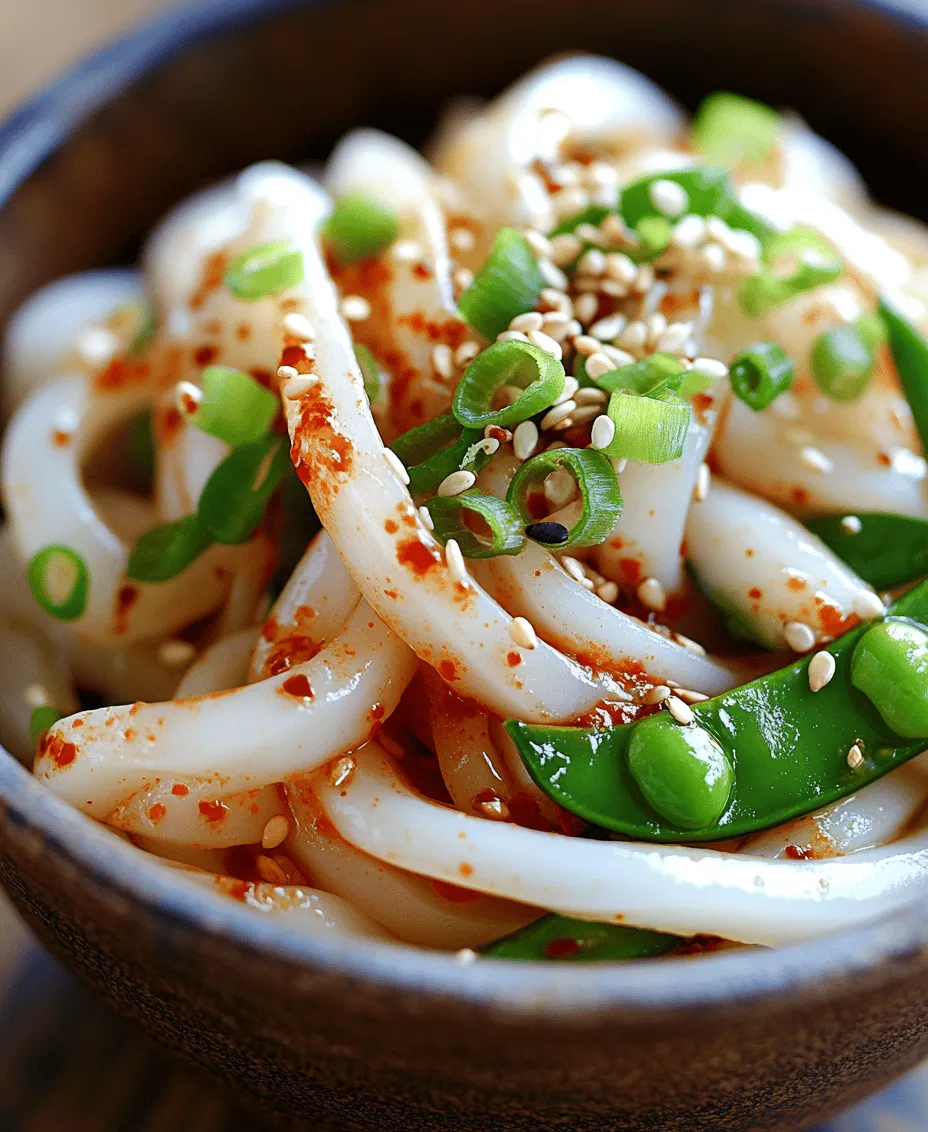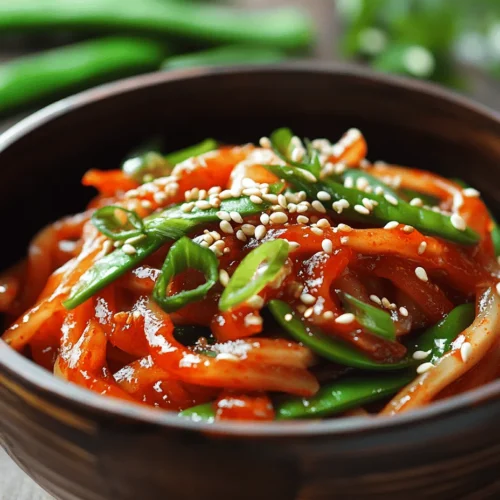Introduction to 10-Minute Chili Oil Udon Noodles
In today’s fast-paced world, finding time to prepare a delicious meal can often feel like a daunting task. As more people seek out quick yet satisfying culinary options, the popularity of Asian cuisine continues to soar, with Japanese dishes, in particular, catching the attention of food lovers everywhere. Among these, udon noodles stand out for their unique texture and versatility, making them an ideal choice for busy weeknights or a comforting lunch.
Our 10-Minute Chili Oil Udon Noodles recipe embodies the essence of convenience and flavor. This dish is not only quick to prepare but also bursting with bold, spicy flavors that tantalize the taste buds. The beauty of this recipe lies in its adaptability; you can easily customize it with various toppings and proteins, catering to diverse dietary preferences. Whether you’re a vegetarian seeking a hearty meal or a meat lover wanting to add grilled chicken or shrimp, this dish can be tailored to your liking.
As we dive deeper into this recipe, you’ll discover how simple ingredients come together in just ten minutes to create a delightful bowl of udon noodles that packs a punch. Let’s explore the characteristics of udon noodles, the essential ingredients needed for this dish, and the simple steps to create a meal that will impress anyone who tries it.
Understanding Udon Noodles
Udon noodles are a key component of this dish and are celebrated for their thick, chewy texture and satisfying mouthfeel. These noodles are made from wheat flour, water, and salt, which gives them a delightful elasticity. In traditional Japanese cuisine, udon noodles are often served in a hot broth, stir-fried with vegetables, or enjoyed cold with dipping sauces. Their ability to absorb flavors makes them a popular choice for various Japanese dishes.
When it comes to udon noodles, you will typically encounter two main types: dried and fresh. Dried udon noodles have a longer shelf life and are convenient for stocking your pantry. However, fresh udon noodles offer a superior texture and flavor, making them the preferred choice for this 10-minute recipe. Fresh noodles have a pleasant chewiness that elevates the overall dish, allowing the flavors of the chili oil and sauces to meld beautifully.
If you’re wondering where to find udon noodles, they can often be located in the international aisle of your local grocery store or at Asian markets. Fresh noodles can usually be found in the refrigerated section, while dried versions are available on the shelves.
Ingredients Breakdown
To create the perfect bowl of 10-Minute Chili Oil Udon Noodles, having the right ingredients is essential. Here’s a breakdown of what you will need:
Fresh Udon Noodles
Using high-quality fresh udon noodles is crucial for achieving the best taste and texture. These noodles require minimal cooking time and provide a delightful chew that pairs perfectly with the spicy chili oil and savory sauces. If fresh noodles are unavailable, you can substitute them with dried udon noodles; just ensure to follow the package instructions for cooking time, as dried noodles typically take longer to prepare.
Flavorful Oils
The combination of chili oil and sesame oil is what elevates this dish to new heights. Chili oil infuses the udon noodles with a spicy kick that excites the palate, while sesame oil adds a rich, nutty aroma that balances the heat. These oils not only enhance the flavor profile of the dish but also create a fragrant experience that makes it irresistible.
Sauces and Seasonings
The flavor of the udon noodles is further enhanced by a few key sauces and seasonings. Soy sauce provides a savory depth, while rice vinegar adds a subtle tang that brightens the overall dish. Sugar is included to balance the flavors, creating a harmonious blend that brings all the ingredients together. Garlic and ginger are essential aromatics that contribute warmth and complexity, making every bite of the noodles a delightful experience.
Optional Vegetables
To add nutritional value and a pop of color, consider incorporating some vegetables into your chili oil udon noodles. Snap peas or edamame are excellent choices, providing a crunchy texture and a boost of vitamins. You can also experiment with other vegetables like bell peppers, broccoli, or bok choy, allowing you to customize the dish according to your preferences and what you have on hand.
Step-by-Step Cooking Instructions
Cooking the Udon Noodles
1. Boil Water: Start by bringing a large pot of water to a rolling boil. This is essential for cooking the udon noodles evenly.
2. Add the Udon Noodles: Once the water is boiling, add the fresh udon noodles. If you are using dried noodles, make sure to check the package for the correct cooking time, as they usually require a longer boiling time.
3. Cook Until Tender: Fresh udon noodles typically cook in about 2-3 minutes. Stir occasionally to prevent sticking and ensure even cooking. You’ll know they’re ready when they become tender yet still retain a slight chew.
4. Drain and Rinse: After the noodles are cooked, drain them in a colander and rinse under cold water. This step helps to stop the cooking process and removes excess starch, allowing the noodles to maintain their texture.
5. Toss with Oil: After draining, transfer the noodles to a bowl and drizzle with a bit of sesame oil. Toss gently to coat the noodles; this adds flavor and prevents them from sticking together as you continue with the recipe.
In the next section, we will delve into how to combine these cooked udon noodles with the flavorful oils, sauces, and optional vegetables to create a stunning and satisfying meal that can be on your table in just ten minutes. Stay tuned for the delicious journey ahead!

Detailed Instructions for Boiling Udon Noodles
To start off, boiling udon noodles is crucial for achieving the perfect texture. Begin by bringing a large pot of water to a rolling boil. It’s essential to use a generous amount of water—this helps to prevent the noodles from sticking together. Once the water is boiling, add the udon noodles. For fresh udon noodles, the cooking time is usually around 2-3 minutes, while dried noodles will take about 7-9 minutes.
Timing is everything; overcooking the noodles will result in a mushy texture. Therefore, set a timer for a minute or two less than the recommended cooking time on the package. Taste a strand a minute before the time is up to check for doneness. The noodles should be tender yet retain a slight chew, known as ‘al dente.’
Once the noodles are cooked, immediately drain them in a colander. This step is crucial as it removes excess starch that can make the noodles gummy. To ensure they don’t stick together, rinse the noodles under cold water for about 30 seconds. This halts the cooking process and helps maintain a firm texture, making them perfect for absorbing the chili oil sauce later.
Creating the Sauce
The magic of chili oil udon noodles lies in the sauce, which is both simple and full of flavor. In a mixing bowl, combine chili oil, soy sauce, sesame oil, and rice vinegar. Start with two tablespoons of chili oil, adjusting based on your spice tolerance. For a balanced flavor, use one tablespoon of soy sauce for saltiness, one tablespoon of sesame oil for a nutty depth, and one teaspoon of rice vinegar to add a hint of acidity.
Whisk these ingredients together until well combined. If you prefer a thicker sauce, you can add a teaspoon of cornstarch mixed with a tablespoon of cold water to the mixture and heat it gently on the stove until it thickens. This step is optional but can help in achieving a more cohesive sauce that clings to the noodles perfectly.
Taste the sauce and adjust the flavors as needed. If you enjoy a bit of sweetness, consider adding a teaspoon of honey or maple syrup. For an extra kick, minced garlic or grated ginger can elevate the flavor profile further. The goal is to achieve a harmonious balance between spicy, salty, and slightly tangy notes.
Sautéing Optional Vegetables
While the noodles are boiling and the sauce is being prepared, you can enhance your dish with sautéed vegetables. Choose vibrant options like bell peppers, snap peas, or bok choy. These vegetables not only add color but also provide crunch and nutrition.
To sauté the vegetables, heat a tablespoon of vegetable oil in a non-stick skillet over medium-high heat. Add the vegetables in a single layer, allowing them to sear for about 2-3 minutes without stirring. This technique helps to lock in their vibrant colors and retain their crispness. Once they start to become tender but still crisp, stir occasionally for another minute or so.
Season the vegetables with a pinch of salt and pepper to taste. If desired, you can toss in a splash of soy sauce during the last minute of cooking for additional flavor. Once cooked, remove the skillet from heat, and set the vegetables aside.
Combining Noodles and Sauce
Now that you have your udon noodles boiled and rinsed, along with the flavorful sauce and sautéed vegetables, it’s time to combine everything. In a large mixing bowl or directly in the skillet used for the vegetables, add the udon noodles. Pour the chili oil sauce over the noodles, ensuring an even distribution.
Using tongs or chopsticks, gently toss the noodles and sauce together, ensuring each strand is coated effectively. This step is critical—proper mixing guarantees that every bite is bursting with flavor. If the noodles seem dry, you can add an additional splash of soy sauce or a drizzle of sesame oil to achieve the desired consistency.
Once the noodles are well-coated, fold in the sautéed vegetables, mixing them through the noodles gently. This way, you preserve their crunch while ensuring they are evenly distributed throughout the dish.
Garnishing and Serving
Garnishing is not just about aesthetics; it enhances the flavor and overall dining experience. To serve the chili oil udon noodles, divide the dish into bowls. For a beautiful presentation, consider garnishing with freshly chopped scallions, sesame seeds, or even a sprinkle of crushed peanuts for added texture.
A drizzle of extra chili oil can also be appealing, especially for those who enjoy an extra kick. Serve the noodles hot, and consider pairing them with a side of pickled vegetables or a light salad for a refreshing contrast.
Nutritional Benefits of Chili Oil Udon Noodles
Chili oil udon noodles are not only delicious but also packed with nutritional benefits. Udon noodles, primarily made from wheat, are a great source of carbohydrates which provide energy. They are low in fat, making them an excellent base for a nutritious meal.
Chili oil, depending on the brand, often contains healthy fats, especially if made with high-quality oils. It can also contain antioxidants, primarily if made with fresh ingredients. The addition of vegetables provides essential vitamins and minerals—bell peppers, for example, are rich in vitamin C, while leafy greens like bok choy add calcium and iron to the mix.
This dish can easily fit into various dietary plans. For vegetarians, it offers a wholesome meal filled with plant-based nutrients. To make it gluten-free, switch to rice noodles or gluten-free udon options that are now widely available. The adaptability of the dish ensures everyone can enjoy it.
Variations and Customizations
One of the best aspects of chili oil udon noodles is their versatility. You can easily customize the recipe to suit your taste preferences or dietary needs. For those looking to add protein, consider incorporating chicken, shrimp, or tofu. Simply sauté the protein of your choice in the skillet before adding the vegetables. This not only enhances the dish’s flavor but also makes it more filling.
If you want to experiment with different flavors, consider swapping the chili oil for another sauce. A teriyaki or sweet soy sauce can offer a sweeter, more umami-rich experience. Adding a splash of lime juice can introduce a refreshing tang that complements the spicy notes of the dish.
For a heartier meal, try tossing in cooked edamame or snap peas alongside the sautéed vegetables. The addition of nuts, such as cashews or almonds, can also provide a delightful crunch and enhance the dish’s nutritional profile.
Embracing Quick and Flavorful Meals
The 10-minute chili oil udon noodles are a stellar example of how quick meals can still be packed with flavor and nutrition. With just a few fresh ingredients and simple cooking techniques, you can create a dish that satisfies your hunger and delights your taste buds.
This recipe’s ease of preparation makes it a perfect choice for busy weeknights or when you want a comforting bowl of noodles without the fuss. Its versatility allows you to adapt it to your dietary needs or flavor preferences, ensuring that you can enjoy it time and again.
Don’t hesitate to make chili oil udon noodles your go-to recipe for quick, flavorful meals that can be enjoyed any day of the week. With the right ingredients and a few simple steps, you will be well on your way to impressing family and friends with this delicious dish.



